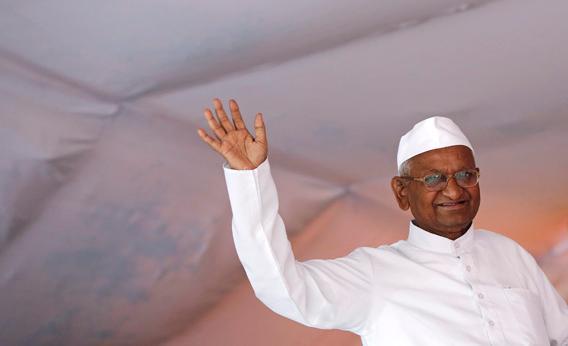NEW DELHI—Anna Hazare dresses like Mahatma Gandhi (white homespun cloth, round spectacles) and uses Gandhian tactics (nonviolent protest, hunger strikes) to fight the corruption he believes is damaging India. In 2011 and 2012, he mobilized hundreds of thousands of Indians, many of them members of the new middle class, to support his “fasts unto death.” Following a 12-day hunger strike in August 2011, he forced a panicked Indian government to agree to a series of demands for anti-corruption legislation.
Hazare’s campaign was successful in part because his language echoes that of India’s founding fathers and in part because he had the support of the staggeringly large and diverse Indian media. In the past two years alone, journalists from more than 100 television channels and countless newspapers in multiple languages helped tell the story of a telecom minister who was arrested and jailed for improperly selling licenses, costing the state as much as $40 billion, as well as that of an army general who said he had been offered a bribe of $2.7 million to buy substandard trucks.
News stories have also featured reports of officials taking apartments meant for veterans’ families, the distribution of illegal mining licenses, the purchasing of parliamentary votes, and the crooked construction contracts written for the 2010 Commonwealth Games. This is nothing new: By one calculation, corruption has cost the Indian state more than $460 billion since independence in 1947. The amounts of money involved do seem to have grown exponentially, but then India’s economy has been growing exponentially, too.
Of course, big corruption scandals are commonplace in the developing world (and the developed world, for that matter). Yet the scale and relative peacefulness of the corruption debate in India may be unprecedented. In Russia, the anti-corruption movement that organized several big protests in 2011 has been stamped out with arrests, police harassment, threats, and violence. In China, corrupt deals at the highest levels take place in secret, with nosy journalists kept far away. Even when accusations are made—as they were against party leader Bo Xilai—trials are masked by rumors and obfuscation.
But unlike China, and unlike Russia, India is a democracy. And although the Indian political system is imperfect in ways too numerous to list here, the central authorities most of the time do respect free speech and free press. Civil society works. Freedom of association works. The question now is how well India’s other democratic institutions work. Protests over corruption—or, more recently, the rape and harassment of women—make the television news. But can they create the deep institutional changes to party financing, to regulation, to policing, and to courts that the new Indian middle class demands?
Around New Delhi, there is no agreement about whether six decades of bad habits can be broken. Clearly, Hazare’s campaign has now lost steam—in Hyderabad last week, only a small crowd showed up at one of his rallies—perhaps because his personality began to overwhelm his cause (one columnist called him a “moral tyrant” presiding over a “comical anti-corruption opera”), and perhaps because many now realize his favored solution—an omnipotent ombudsman—is insufficient.
Others throw their hands up at the scale of the problem, which is much broader than even the reported scandals suggest. Indians pay bribes to get birth certificates for their children and death certificates for their parents. They find business, any kind of business, impossible to conduct without payoffs. In her book Behind the Beautiful Forevers, Katherine Boo describes a boy from the slums who is wrongly accused of a crime, thus dragging his entire family into a netherworld of corrupt police, lawyers, and politicians.
But the optimists feel sure that something is changing. The writer Gurcharan Das, speaking of the telecom scandal, points out that “never before have people”—he means high-ranking people—“actually gone to jail. That’s new.” Shashi Tharoor, a government minister, notes that the protests have led to the creation of legislation that had been “stalled for four decades.” If anything, the demonstrations that followed the horrific rape and murder of an Indian college student on a New Delhi bus in December provoked an even faster reaction from legislators, who have already taken statements from 80,000 Indian women and recommended dozens of changes.
The next question is whether apathetic voters can be moved by these changes, whether they will support clean politicians, whether they will rally behind programs for political and even constitutional reform. India’s next choices matter, and not just for India. A better governed India would be the best possible advertisement for the benefits of democracy across the developing world.
